Diversity Training
Once upon a time (stop me if you’ve heard this one), our primary consideration in planning an excursion into the Great Outdoors was limited to researching what birds might be found at a particular location. Was fall or spring migration in progress? Could we hope for wintering birds? Perhaps new bird families would offer an opportunity to observe chicks pestering parents for food or practicing flight lessons.
As time progressed, so did we. It turns out there are more things in nature than just birds! (Do NOT tell birders this. They will not accept your premise.) My Very Best Friend, who is incredibly intelligent, has always been blessed with an open mind and has avoided the curse of tunnel vision with which I am often afflicted. I might be focused on a Scissor-tailed Flycatcher and how best to frame it within the camera’s viewfinder and my VBF will pipe up: “Oooh, what a pretty dragonfly she has caught!”
Evolution. Bird watchers are typically naturalists at heart. Those feathered creations live amongst majestic trees, gorgeous flowers and vast fields all of which also provide homes for hordes of other life forms. It is just not possible to ignore all that nature offers. So, we just try to embrace it.
This poor excuse for a “blog” has been changing somewhat to reflect our interests beyond birds. It is difficult to predict if that trend will continue or if there will be a step back into what has been a “comfort zone”. We’ll see.
Our local state park is 22 minutes from here and provides a pretty good example of how diverse nature can be. Colt Creek State Park contains over 5,000 acres (2,000 Ha) and consists of native long-leaf pine flatwoods, lakes, streams, open vistas, cypress domes and an incredible variety of life which calls it home.
Herewith, a small sampling of what a morning of observation recently produced.
Small clouds of gold hovered above the path along the lake. Wandering Gliders (Pantala flavescens) patrol the area to defend their territory.

A pair of Northern Parula tirelessly hunted for insects and delivered their bounty to hungry new mouths unseen in the nearby oak trees.
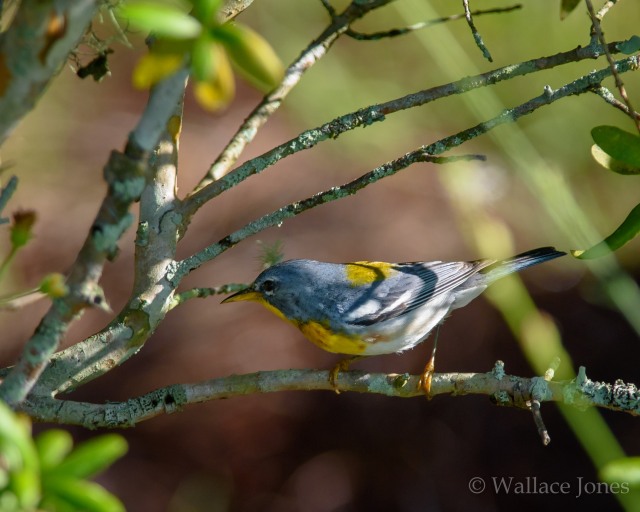
Although their nests are common around human habitation, we don’t often notice the Black and Yellow Mud Dauber (Sceliphron caementarium) in the wild. Capable of delivering a sting, they are seldom aggressive. They pack the cells of their nests with spiders, so that may be a mark in their favor for some.

Guardian of the facilities! This Squirrel Treefrog (Hyla squirella) was perched on a door hinge to the restroom. Small but colorful.

The “calico” plumage of a Little Blue Heron lets us know she’s likely less than two years old. I interrupted her preening and you can see a feather remnant in her beak.
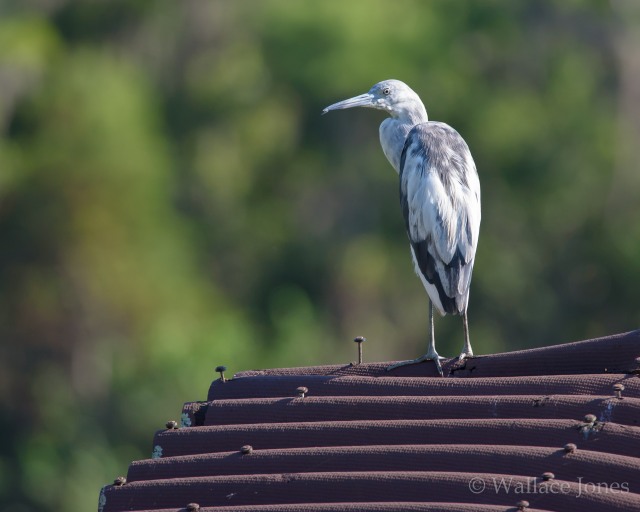
I sometimes think film-makers use nature to inspire their on-screen alien creations. A Leaf-footed Bug (Acanthocephala femorata) would make a good movie star!
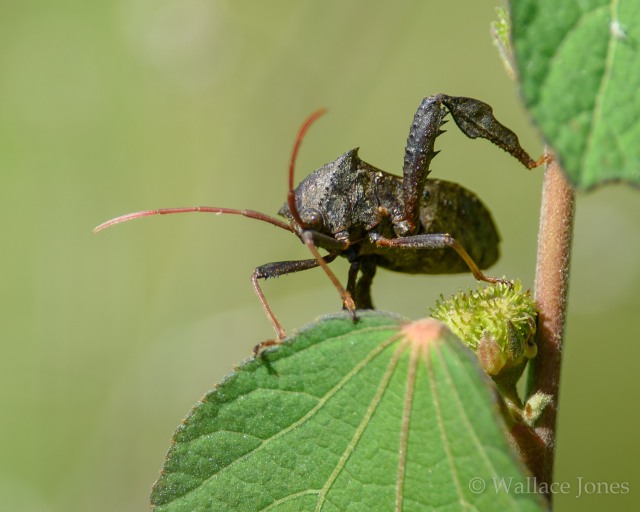
A New Species! It’s always exciting to come across something new. Gini saw a large butterfly that turned out to be just that. At first, we thought it was one of our dark-colored swallowtail varieties. But wait – no “tails”! Turns out it is a Red-spotted Purple (Limenitis arthemis astyanax) and this area is probably pretty much the southern limit of its range.


One of the few flycatcher species to breed within Florida, the Great Crested Flycatcher, has beautiful lemon-yellow, rich brown and gray plumage. Their loud, clear whistling call rings out through the forest at this time of year.

Sports model. The Blue Dasher (Pachydiplax longipennis) with his racing stripe thorax and dusty blue abdomen looks ready to dash off on a moment’s notice.
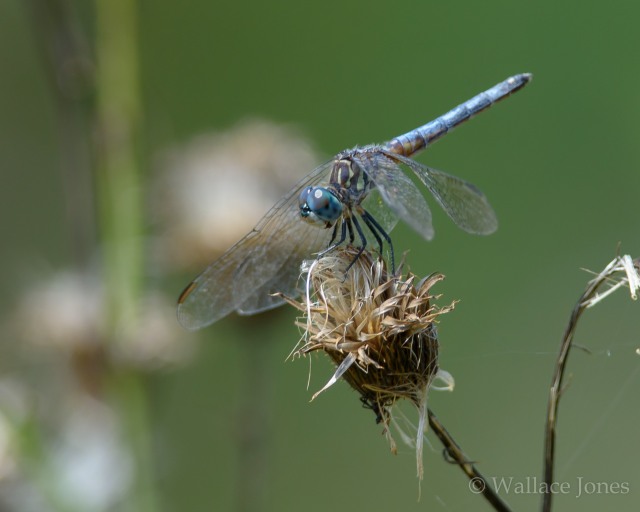
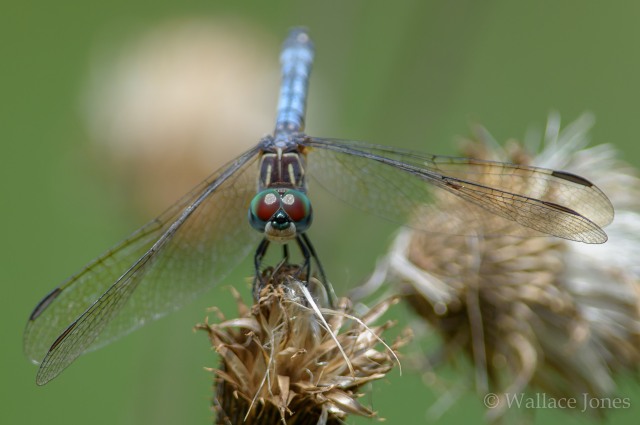
Blackberries are ripening and Wild Turkeys are quick to take advantage of the harvest!

Here are a few examples of the parks floral selection, which explains why so many pollinators love it here. Us, too!
Common Buttonbush (Cephalanthus occidentalis).

Pale Meadowbeauty (Rhexia mariana).
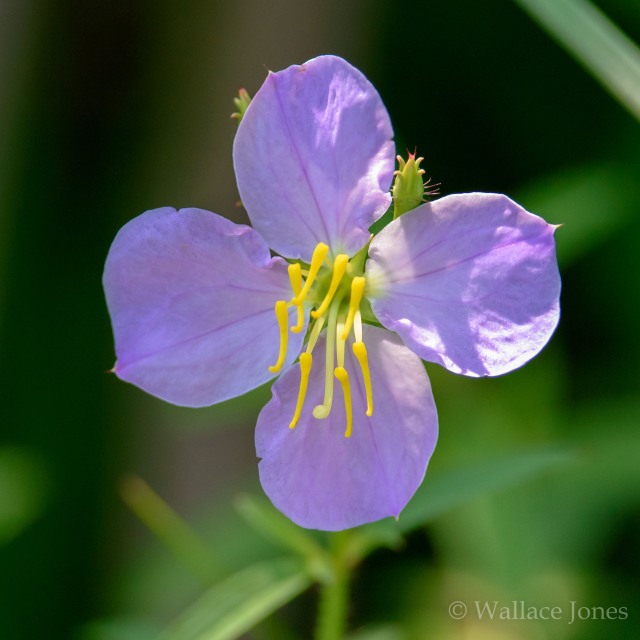
Leavenworth’s Tickseed (Coreopsis leavenworthii). (Don’t know the insect.)

Spurred Butterfly Pea (Centrosema virginianum).

Purple Passionflower (Passiflora incarnata).

We love birds and birding. We love the fact that birding opened our eyes to so much more to discover. Hopefully, you, too, have a love for Nature’s diversity and places to go to see it all.
Enjoy your search for a natural place and come back for a visit!
Beautiful series and variety, Wally! Any thing nature gets me excited to want to explore! 😊
LikeLike
Thank you, Donna. Us, too!
LikeLiked by 1 person
Hello,
What a wonderful post, beautiful collection of photos. Everything nature related is lovely.. Take care and stay safe! Have a happy day!
LikeLike
Thank you very much, Eileen! Each day is Happy around here. Gini will not have it any other way. 🙂
LikeLiked by 1 person
I’m guilty too.True, I pay attention to all of nature, and when birding is slow my subjects are often creepy and crawly things. Dragonflies are my nemesis. Though I can remember the whole sequence of the name changes and the splits and lumps of birds, I seem to meet the same “new” dragonfly year after year, which heightens my spirit of discovery. Oh yes, my brain may say “Sparrow Hawk” or “Marsh Hawk,” no matter how deep I try to bury the memories. Thank goodness Baltimore Oriole and Wilson’s Snipe are back in style, but why “Common Gallinule” for that obvious Moorhen?
LikeLike
Great points, Ken!
Every year yell “Marsh Hawk” when I spot the first migrant of the season.
And no one seems confused when I mention I saw Moorhens.
I learned a new term for my “senior” status this morning. When I complained to the doctor about being old, she said “You’re just well-seasoned”!
LikeLike
I agree Wally. The world is full of birds, for the birds and too many birds where nothing else is important. Except maybe red wine?
Occasionally my blog may stray into a single image of a weed, a creepy-crawly or even food. More rarely it may wander into politics when sufficient steam escapes from my ears and my top is ready to blow. Otherwise, it’s birds.
How expansive of you to include a few birds in your diverse, creepy-crawly blog. And a name like Yellow Mud Dauber and it being poisonous to boot, must have been found by a Brit in the days of invasion of your long lost continent.
On the subject of politics, and of creepys, how is Joe? I hear he is not too well. Perhaps like too many in the US, but few here in the UK other than the BBC, he is suffering from TDS?
Best regards to you both.
P.S. “Comments” would be easier at the bottom of the page. Or, as we prefer, at the “arse”.
LikeLike
Since I am, by nature, lazy, the blog will usually contain material that’s relatively easy for me to acquire. During migration, there are many more birds around than in summer. In the summer heat, I am reduced to crawling about in the grass hoping for an obliging insect to remain still for a moment.
Your wonderful blog on the other hand, not only reflects your abiding interest, but is actually informative, scientific even!
I reckon that’s why on the 8th day, the internet was created. So we could all share our interests.
No word on Joe. I do appreciate his campaigning strategy though. Remain in the basement and give no interviews. All politicians should take a cue!
LikeLiked by 1 person
I’d been wondering about the recent changes to your blog, Wally – and this explains things. I think your diversification is going remarkably well. Just look at the evidence in this post!
Ed
LikeLike
Thank you, Ed. My old brain resists change so it’s a challenge! One day at a time …..
LikeLike
Interesting observations, Wally. I think we are all, we naturalists, fans of the natural world writ large, and are fascinated by form and diversity, and anxious to preserve it all. It is interesting to examine how our specific interest colours our interpretation of an organism. An acquaintance of mine is a worm biologist and calls a robin a predator! Stay safe.
LikeLike
Yes, David, perspective is everything!
We just love it all and can’t get enough. But we shall keep trying!
It is another weekend already! Go out. Take pictures, Continue to tell us about it. Thank you!
LikeLike
Ooh. And ahhh.
I am an unashamed beauty addict (and nature is the best artist, with an astonishing colour palette and spectacular galleries).
Thank you this.
I do love birds, but refuse to be limited. Which is possibly an excuse for monkey mind which finds awe and wonder everywhere.
LikeLike
Your “oohs and ahhs” sound like us every time we go out!
You have introduced a new phrase for us: “monkey mind”! I plan on using it often! 🙂 (Both as a phrase and as a way of looking at nature!)
LikeLike
I can fully relate to your thoughts on the evolution of one’s interests, Wally, and this fabulous post beautifully exemplifies how broad your horizons have become. My own journey has been a little different:- birds – then specifically owls – insects – then specifically dragons and damsels – back to insects in general – and now I feel a return to birds shaping up.Sadly, there aren’t too many places local to me that are Covid-safe and productive bird-wise too. I’m starting to spread my wings again, however, so maybe I’ll head in that direction soon.
All is good here, although the stress levels are a little high at present. My very best wishes to you and Gini – please continue to take great care in these difficult times – – – Richard
LikeLike
Thank you for your very nice comments, Richard. I’m sure we all focus on different interests throughout our lives. We may return to some, discard others and, ultimately, choose what makes us happy has humans.
Gini and I are happy! We wish the same for you and Lindsay.
LikeLike